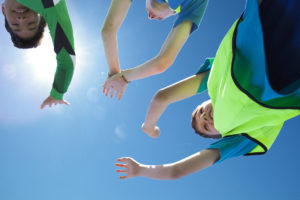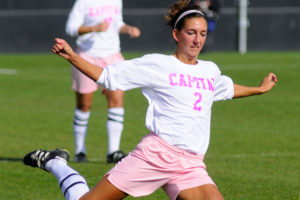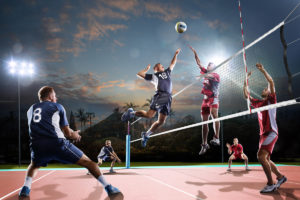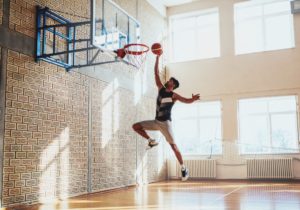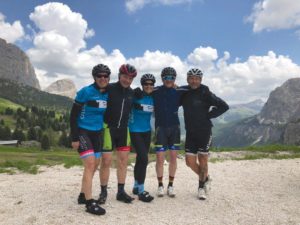Athletes
Benefits of Athletic Brain Endurance Training
We’ve all experienced mental fatigue—that feeling when you’re too tired to pay attention or make decisions. Mental fatigue can lead to increased accident risks and poor choices. Elite athletes practiced…
Many Female Athletes Need to Eat More
For the most part, sports nutrition science is bro-science. That’s because the vast majority of studies to date have focused on men, leaving active women to assume the same results apply to them. But that is slowly changing.
Complex Training: Pairing for Power
If you work with athletes, you’ve likely run into the challenge of how to incorporate power components into their already-packed training schedules. Whether you’re working with a clutch outfielder, a center or a lineman, your client’s athletic skills need refinement, and power is one aspect that requires attention. Trainers typically program resistance training to develop strength and plyometric drills to improve speed.
Training Techniques for High-Performance Masters Athletes
Trainers and coaches can use examples of elite performances and aging research to develop training protocols for masters athletes.
Increase Neuromuscular Power for Your Athlete Clients
Competitive athletes often train for peak neuromuscular power to excel at the complex movements their sports require. Many personal training clients want to apply the same principle to their favorite sports.
With the right power training, fitness competitors can improve their tennis serve, golf swing, running speed, volleyball spike, soccer performance, basketball vertical jump and so on.
Playing Team Sports Fights Depression in Boys
Participation in team sports not only helps children improve fitness and social skills; it’s also linked with development of the hippocampus region of the brain, according to research published in Biological Psychiatry: Cognitive Neuroscience and Neuroimaging (2019; doi:10.1016/j.bpsc.2019.01.011). In adults, lower hippocampal volume has been associated with depression for some time.
The Science of Pilates Research
When Victor Sanakai was playing tennis for the Auburn University Montgomery National Championship team, he thought he was going to need rotator cuff surgery. But first he sought the advice of Michele Olson, PhD, a Pilates researcher who works with student athletes.
Olson, a senior clinical professor of sport science at Huntingdon College in Montgomery, Alabama, suggested Sanakai try Pilates exercises for the shoulders, upper back and abdominals.
Genomic Insight: Precision Sports Nutrition
Currently, the extreme competitiveness in sport and the constant record-breaking achievements have reached levels never before seen in sports history. Sports equipment and technology have reached the point where restrictions are being implemented to keep the game fairer for all. Pharmacological sports enhancement drugs have been banned in all sports by international sports federations and the psychological input have all but exhausted their methods. What is left for the athlete to optimize performance and still raise the bar of performance?
Americans Enjoy Fitness More Than Sports
When it comes to being physically active, more Americans choose fitness pursuits over sports, according to the Sports & Fitness Industry Association’s 2019 SFIA Topline Report. The report is based on nationwide survey data across activity categories and includes responses from children (ages 6 and up) up to older adults. In 2018, fitness categories that use equipment reflected the highest growth. And, compared with 2013, at least 3.5% more Americans attended class-based exercises such as HIIT, cross-training, barre and yoga.
Are Compression Socks Effective?
A study involving amateur female soccer players found that those who wore compression socks during a match experienced less game-induced fatigue than teammates who wore regular socks. Investigators evaluated fatigue by testing agility, standing heel-rise and other factors immediately after the match.
How to Improve Tennis Performance
Tennis is one of the most popular sports in the world. In the U.S. alone, there are almost 18 million players, with another 14 million expressing interest (TIA 2018). Unfortunately, the dynamic, forceful twists and turns of the game pose ever-present injury risks to players (Roetert & Kovacs 2011).
Neuromuscular Power Circuits
The dynamic motions of sport require peak power—that is, the most strength a muscular contraction can muster in one of these quick bursts. Sporting athletes depend on peak power for jumping, running, throwing, striking, swinging and kicking. Scientists prefer the term “neuromuscular power” (to just “power” itself) because neural factors—including motor unit recruitment, muscle fiber firing frequency and synchronization of a muscle’s contractile forces—are involved.
The Benefits of Plyometrics in the Water
Athletes who practiced jump training in water significantly improved jump height and peak power without increased injury risk, according to findings published in PLOS One (2018; 13 [12], e0208439). Researchers from the University of Technology Sydney compared athletes who performed jump training in water 1.2 meters (3 feet 11 inches) deep with athletes who followed their regular sports training—without added jump training—on land. Both groups trained three times a week for 8 weeks.
Neuromuscular Power Training for Athlete Clients
To help clients with power training, you need to understand the fundamentals of neuromuscular power development.
Hot Yoga May Provide Heat Stress Conditioning for Athletes
If you’re looking for a good cross-training technique for your more athletic clients, suggest they practice hot yoga, which may boost aerobic performance while minimizing exercise stress.
University of British Columbia, Vancouver, researchers recruited 10 elite female field hockey players for observation. All athletes participated in 60-minute hot-yoga classes (30 degrees Celsius/86 degrees Fahrenheit) over 6 consecutive days, during which they did not engage in any other exercise. Following the intervention, the athletes played in a national-team camp.
Snowboarding: Injury Prevention & Performance
Over the past few decades, snowboarding has quickly become one of the fastest-evolving and most popular winter season sports. The impressive combination of power, velocity and technique make this activity appealing to both recreational riders and high-level competitors. But speed, terrain, gravity and the unique snowboard stance also create the potential for injury.
The Peak of Fitness
The mountains are calling. The jagged and distinctive Dolomite range—part of the Italian Alps in northeastern Italy—features 90,000 acres of mountainous terrain, perfect for outdoor adventure enthusiasts from across the globe, including a dedicated group led by PJ O’Clair, owner of ClubXcel and Northeast Pilates Education Center and a cycling enthusiast.
Keto—Fat Chance of Performing Better
The ketogenic diet, a fat-forward meal plan that limits followers to about 20 grams of daily carbs, may help some people shed a little weight (in the short term), but it might not be good news for their athletic pursuits.
Equal Calories Burned ≠ Same Results
Many people fixate on the number of exercise calories they burn. New research, sponsored by Les Mills International, shows that even when two group fitness activities (indoor cycling and a resistance workout) were matched for duration and caloric expenditure, they did not have equivalent metabolic effects—which could influence long-term training results. Lead study author Nigel Harris, PhD, said, “The type of exercise used to burn those calories . . . impacts the long-term positive effects that exercise has on the body.”
The Group Dynamic
clients: Ben, Pat, Jacob (trainer), Jeanine, Tania, Jennifer | personal trainer: Jacob Trione, CEO and Founder, Triaffect Fitness | location: Clear Lake City, Texas





